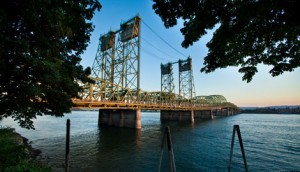Podcast: Download (Duration: 2:42 — 3.7MB)
Audio: Phone interview with Initiative 1125’s author, Tim Eyman.Summary: Scheduled for a vote on the Nov. 8 ballot, Initiative 1125 is an effort to place restrictions on how government determines, collects, and spends toll revenue.

I-5 Columbia River bridge: The CRC proposes using tolls to help pay for the $3.6 billion CRC Light Rail project.
Proponents say Initiative 1125 creates greater transparency and accountability in the process and preserves the common-sense idea of tolls paying only for specific highway-only projects.
Opponents say that giving the responsibility of toll-setting to the legislature makes toll-backed bonds impossible to sell on the open market due to political volatility in Olympia. As a result, they claim there will be fewer funding options available for transportation projects.
For Clark County voters who have long clamored for a vote regarding the $3.6 billion ($8.7 billion with financing) Columbia River Crossing Light Rail project (CRC), Initiative 1125 isn’t quite it – but if passed, the initiative does put some new parameters on the project’s finances.
At its most fundamental, Initiative 1125 argues that tolls should pay for the construction projects for which they are intended and end as soon as those projects are paid off. It also reiterates existing law that prevents government from redirecting toll revenue from one project to fund something else, such as light rail.
“This measure protects our gas taxes and toll revenues from a legislative raid by giving voters the chance to reaffirm their support for the 18th Amendment to the Washington Constitution,” said Initiative 1125 author Tim Eyman in a recent policy release.
Mike Ennis, director of the Center for Transportation at the Washington Policy Center in Seattle, says Initiative 1125 preserves the common-sense assumption that a toll is a user fee for a specific road or bridge. That’s how the state has always done things.
“It makes the state use tolls in the same way they have in the past,” said Ennis, who has prepared a voter’s guide on Initiative 1125. “We funded 14 different bridges in the state with tolls. You put the toll on the infrastructure.”
Another central goal behind Initiative 1125 is to take the authority for setting toll rates away from the Washington State Transportation Commission (WSTC) – a group of seven unelected citizens hand-picked by the governor – and gives it instead to elected state legislators.
Eyman defended the merits of Initiative 1125 during a Sept. 29 debate televised on Washington’s public affairs channel TVW and hosted by the Seattle Times. Joining Eyman in support of Initiative 1125 was Bellevue businessman Kemper Freeman. Former Washington State Transportation Secretary Doug MacDonald and Bellevue businessman John Stanton spoke in opposition.
Eyman said that requiring legislators to set toll rates introduces essential accountability into the process, something he doesn’t think the bureaucracy of the transportation commission can provide.
“When it comes to Olympia taking more of our money, we think it needs to be our elected representatives that make the decision, and not the unelected bureaucrats at state agencies,” Eyman said.
MacDonald argued that forcing the legislature to set toll rates will make toll-backed revenue bonds too volatile, and, therefore, too expensive on the bond market. Referencing a report by Washington State Treasurer James McIntire, MacDonald warned that investors would hesitate buying toll-backed bonds if legislators might alter toll rates in the future.
“That’s why this initiative pulls the pin out from project financing,” MacDonald said.
MacDonald added that without toll-backed bonds as viable funding sources, the state would have to make up the difference by increasing the state gas tax. Washington drivers already pay one of the highest gas taxes in the nation, 55.9 cents per gallon.
Among its eight provisions, Initiative 1125 will also prohibit variable tolling, the practice of charging motorists more during peak hours. Washington currently has fixed tolling on the Tacoma Narrows Bridge and variable tolling on high occupancy toll (HOT) lanes on SR 167 between Auburn and Renton.
Freeman, a developer, considers variable tolling akin to social engineering that punishes people for simply driving to work. He sees fixed tolling as a way to protect lower income drivers who may not be able to afford peak-hour tolls.
Variable rate tolling encourages the design of undersized highways that depend on restraining users to reduce the resulting congestion during rush hour, rather than designing highways with sufficient capacity to satisfy the needs of the users without congestion.
“This is a government monopoly,” said Freeman. “What are your choices? If these tolls get too high, we are penalizing people. It’s becoming prohibitively expensive.”
Initiative 1125 will also prevent the Washington Department of Transportation (WSDOT) from leasing vehicle lanes on Interstate 90 for light rail construction. Freeman lost an appeal to the Washington State Supreme Court earlier this year in which he argued that vehicle lanes originally constructed with revenue from gas taxes can only be used for highway purposes.
Ennis doesn’t believe Initiative 1125 is a death knell for the CRC, but the initiative will bring some definite restrictions. It certainly settles the question whether the CRC could change its mind and use toll revenue for light rail construction should fewer New Starts Light Rail funds be available.
“[The CRC] would not be able to have variable tolls,” said Ennis. “Tolls would go away once the project is completed. Most significantly, you would not be able to use the toll revenue for transit.”
To learn more, see the following links:
Yes on 1125: www.yeson1125.org
No on 1125: voteno1125.com/ Fiscal analysis: www.ofm.wa.gov/ initiatives/2011/1125.pdf
Voters’ pamphlet explanation: tinyurl.com/Initiative1125
Statement by State Treasurer Jim McIntire: www.tre.wa.gov/news/pr110812.shtml










